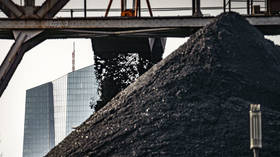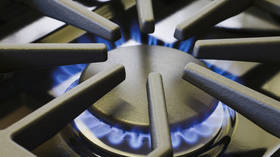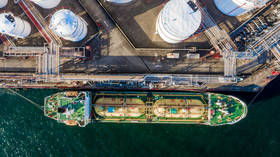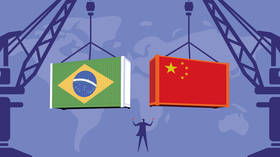How EU leaders destroyed relations with Russia – and denied their citizens access to reliable cheap energy

The European Union has survived the first acute phase of its current energy crisis, but it is not over yet – and consumers are unlikely to see their bills as low as they once were any time soon.
The price of natural gas in Europe is at an 18-month low – lower than before the military operation in Ukraine that triggered the EU's drive to break away from Russian supplies. This is thanks to a combination of demand dropping as winter ends, increase in supply of dirtier alternatives – such as coal – and vast amounts of money poured into topping up EU storage facilities with gas from other sources.
But the crisis has taken its toll, driving inflation to heights not seen in nearly 50 years and strangling the bloc's consumers and businesses alike. Most importantly, unprecedented sanctions placed on Russia, the premier provider of affordable energy, coupled with the sabotage of the Nord Stream gas pipelines, has alienated the EU’s most dependable energy partner irrevocably. Simply put – Russian energy is pivoting away from Western Europe.
Replacing it will not be easy and bringing Moscow back to the energy security table will be nearly impossible. Russian Foreign Minister Sergey Lavrov made this clear last year when discussing the diplomatic situation, stating, “It is no surprise that these relations are absent today. But we never shut down. I will only say that we will never trust the United States or the European Union again.”
The key word here is “trust” and it isn’t ambiguous diplomatic speech. Rational people understand the importance of trust.
A ‘trust’ crisis
This brings us to Western Europe’s current crisis. The EU, overall, is a net importer of both fossil and nuclear fuels and has been for decades. Russia has been supplying large quantities of oil, gas, and petroleum products since the 1960s and 1970s under agreements first established between the West and the Soviet Union. Moscow inherited the bulk of the USSR’s resources and is an energy powerhouse.
In 2020, Russia’s oil and gas production were both ranked #2 in the world according to the 2021 International Energy Agency Key World Energy Statistics report. Russia ranks 6th in coal production and in the top ten of mined uranium. According to the European Council, it accounted for roughly half of all of the EU’s gas imports up until June of 2021. Norway is the only other European country that makes the top 15 in gas (#8) and oil (#11) in production.
EU member states are left with a daunting challenge in how they replace Russian energy, which will not completely stop, but it has and will continue to diminish in volumes. For oil, the task will not be as difficult since there are a plethora of oil producers in the world that can fill the demand while Russian oil will find its way to other markets.
Gas is more problematic and for several reasons. First, transporting gas is more difficult and more expensive. The only economical way to ship gas by sea is to convert it to liquefied natural gas (LNG) by freezing it. This system requires a special terminal at the point-of-origin to freeze it and another at the destination to convert it back to usable gas. This raises the cost significantly, by as much as 40% more than the price for pipeline gas typically, but even more when demand is greatest. Construction of these special facilities takes time and large amounts of capital.
Alternatively, pipeline gas requires an investment into building and maintaining a network from the origin to the destination. The greater the distance, the higher the costs for construction and maintenance. Still, compared to LNG terminals, pipelines are far more cost effective and profitable, provided you have a guaranteed customer on the receiving end.
This is where the EU’s trust problem comes into play.
The Soviet Union, and then Russia, laid out the capital to build all the necessary pipeline infrastructure to ship gas to the West. In the beginning, the energy was traded for technology and high quality materials like German steel, compressors, and machinery that was used in building and maintaining the pipelines. It was a win/win scenario for the partners, but still it began slowly and developed over time – decades.
The Western Europeans and the Soviets built upon that trust layer by layer with each year, bringing more trade between the two Cold War adversaries. Author Per Högselius details the evolution of this relationship in his book, ‘Red Gas: Russia and the Origins of European Energy Dependence’, and he notes how both sides worked diligently towards meeting their obligations to the other. Each of the partners was partly driven by ideological pride, and in the case of the Soviet Union, even sacrificed domestic needs on occasion in order to fulfill gas deliveries.
While Högselius does take a somewhat cynical view of the growing energy dependence of the EU, a more balanced review reveals that the West and the East began to develop a partnership based on trust and mutual benefit – one that transcended Cold War animosities.
For 50 years, that relationship endured, continuing after the dissolution of the Soviet Union. Russia continued to meet its obligations to its Western partners nearly without fail. Ironically, the only interruption of gas deliveries that has ever occurred before now took place in the winter of 2008-2009, when the newly elected Orange Revolution government of Ukraine stopped transiting gas for a short period of time, cutting off supplies to its European neighbors due to a supply and payment dispute with Gazprom.
The trade relationship between Russia and its Western European partners weathered countless political storms, social upheavals, border changes, and saw the development of a gas network rivaled only by the extensive pipeline system in the US. The mutual investments into the various pipeline networks, including Nord Stream 1 and 2, are mammoth and include principals and actors throughout Eurasia.
EU households and businesses received affordable energy and Russian energy companies grew along with government tax revenues. Then Western leaders in the EU and US went to war against Moscow's economy.
A separate article, maybe even a book, could be written on the herculean measures the EU and the US took to reduce and eliminate Russian energy supplies to Western Europe, but the bureaucrats’ war started in the 2000s and has led to where we are now.
In short, the EU began by making a series of regulatory changes named “energy packages” (sound familiar?) with a stated goal of improving the competitive nature of the gas business in the bloc. The key problem with most of this approach was the lack of significant competition from other gas producers, meaning that most of these reforms were directed at and endured by Russian gas.
Russia companies made several attempts at bypassing Ukraine as a transit state, since Kiev continued to prove it was an unreliable partner. Both corruption, and the country's poor economic performance encouraged theft from transit gas (as happened in 2008-2009). The EU (encouraged by the US) stopped or delayed several initiatives such as South Stream (through the Black Sea) and the Nord Stream pipelines, which were plagued by delays on “environmental impact” grounds.
By 2014, following the Maidan coup in Kiev, Russia was hit with sanctions on its oil and gas sectors in response to re-incorporating Crimea.
Where does that leave the EU populace?
How will the EU replace that flow of resources at affordable prices? The short answer is – it won’t. The numerous sanctions packages targeting Russia’s energy sector, the outright theft of Russian assets and holdings within the Western financial framework, and the ‘mysterious’ destruction of the Nord Stream pipelines with a completely opaque investigation by Denmark, Sweden, and Germany has reduced, if not erased, trust – both existing and potential.
Most of the reporting is focused solely on the economic consequences, such as the spike in energy prices in the EU and the inflationary pressure it has put on getting goods to markets, which exacerbated the challenges of consumers. Meanwhile, people throughout the EU were being encouraged to “suck it up” and support Ukraine by turning down the heat in the middle of winter. German factories were going bankrupt, British pubs faced closure, families were struggling to heat their homes, and US and EU leaders blamed Russia.
Price caps placed on oil and petroleum products have failed to devastate the Russian economy and have hurt EU citizens through higher prices, but greater damage has been done to the the bloc's reputation as a reliable trading partner.
Eyebrows were raised in OPEC+ countries and the mineral-rich Global South in response to the US, EU, and G7 measures against Russia. The biggest fallout from the West’s anti-Russia measures is that other trading partners have become wary of the ‘rules-based order’, which can change quickly and unpredictably. Contingency plans, if not already in place, have been quickly developed by resource-rich countries in case they find themselves in the West’s crosshairs next.
Where will the EU get its gas in the future?
The US won’t be able to ship enough LNG to cover the loss of Russian gas flows – not even close – and the gas the US does supply will come at three times the cost or more. According to energy consulting firm Timera Energy in a winter price outlook, “LNG alone cannot meet this volume, considering a lack of new global liquefaction capacity in the short-term, including in the US, limited further demand elasticity in Asia, and European regasification capacity constraints. Therefore, European demand will need to fall.”
Other countries aren’t going to line up to build billion-dollar pipelines to supply the EU knowing they might get sanctioned sometime in the future or the US might just destroy the pipeline altogether. They are well aware of what happens if you fall out with the US and NATO – see Iraq, Libya, and Syria for examples.
These circumstances are pushing the EU back towards coal to fill the gap, which moves the bloc in the opposite direction in meeting its ambitious clean energy goals. Germany, Poland, and Ukraine (which sells excess coal to the EU) have increased production of the “dirty fuel” to compensate. The EUs renewable energy initiatives have been admirable, but they still aren’t competitive on price despite huge subsidy infusions from some countries and they also don’t produce enough consistent energy.
The EU will survive this crunch and find solutions eventually, but at a high cost. The pity is that it had a dependable, trustworthy trading partner providing the cheapest and currently cleanest solution to meet its energy needs. But Western leaders chose to take extreme measures against Russia and have now passed the point of no return.
For Moscow’s part, it is moving on. At his recent meeting with Chinese President Xi Jinping, Russian President Vladimir Putin said almost all parameters of the agreement on the new Power of Siberia 2 gas pipeline had been settled. According to Russian Deputy Prime Minister Aleksandr Novak, the deal is expected to be struck by the end of this year and the new pipeline will add an additional 50 billion cubic meters of gas to existing exports that “will completely replace the Nord Stream energy network.”
Trust is important. It is the foundation of civil society and of cooperation. Participants in the exercise of cooperation make decisions based on the previous decisions of their partners, as anyone familiar with basic game-theory is aware.
It's even more vital in energy because of the long-term return on investment required. Companies need to know they have guaranteed sales and trust before investing tens of billions into developing energy sources and appropriate infrastructure. As such, contracts are made in terms of decades and not years for new projects.
In order to achieve the long-term results in cooperation, the EU will need to take less optimal decisions in energy relations in the short term going forward if it hopes to secure new partnerships. Unfortunately, that means the bloc's citizens will bear the burden of cost until a point in time that trust and credibility can be reestablished.
Immediate solutions won’t come cheap, and affordable solutions won’t arrive in the foreseeable future. The bloc has finally run off the best energy partner it ever had.
So, while many Europeans freeze and spend more of their hard earned salaries on utility bills, they can look to the Americans with their relatively cheap heating and electricity and their own leaders with new heated pools and thank them for ‘standing with Ukraine’.
The statements, views and opinions expressed in this column are solely those of the author and do not necessarily represent those of RT.

















